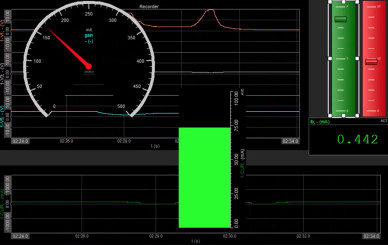MonoDAQ-U-X: Measuring (via a USB port) with DEWESoft
February 14, 2019
on
on
 MonoDAQ-U-X is a new multi-function measuring device. That's not all you can say about it, even if it just looks like a rather modest measuring box powered by a USB-C port. The single USB-C cable to the back of the box is thus used for power and communication with a PC. Galvanic separation is assured by isolating the power and signal lines immediately behind the USB connector. At the front, the 8 multi-function terminals of the connector are configurable as inputs or outputs, analogue or digital. The configuration of each channel is done with the aid of a table in the DEWESoft software. Ah, software, that great all-encompassing word!
MonoDAQ-U-X is a new multi-function measuring device. That's not all you can say about it, even if it just looks like a rather modest measuring box powered by a USB-C port. The single USB-C cable to the back of the box is thus used for power and communication with a PC. Galvanic separation is assured by isolating the power and signal lines immediately behind the USB connector. At the front, the 8 multi-function terminals of the connector are configurable as inputs or outputs, analogue or digital. The configuration of each channel is done with the aid of a table in the DEWESoft software. Ah, software, that great all-encompassing word!
Familiarising yourself with the DEWESoft software
Following his review published last month, Clemens Valens hasn't had the time to either use or even familiarise himself with the software and use it for a demonstration with the MonoDAQ-U-X.But now it's a done deal, and you can find the video below. Measuring the gain of an NPN transistor shows how to use a channel of the MonoDAQ to power the circuit under test, another as an output then as an input to measure the current supplied to the transitor under test. One other terminal of the MonoDAQ is configured as an input to measure the voltage on the collector. And as the MonoDAQ only has one current measuring input (already used) two other inputs are used to measure the base current (on the connections of the base resistor).
As the Hardware-Software combination of the MonoDAQ-U-X / DEWESoft seems promising, it is very probable that we will soon have more demonstrations with other examples of this cooperation. Don't hesitate to let us know of other subjects you would like to see tackled.
Sigma-delta with sampling < 50 kS/s (16 bits)
Under the hood, the main link in the measuring chain is the sigma-delta Analogue Digital Converter (ADC) with a sampling rate of up to 50 kS/s (16 bits) and maximum resolution of 20 bits (100 S/s). Using only one channel, the signal is free of aliasing effects in a pass band of 0.4 times the sampling frequency. With several channels in use, the signals are multiplexed ahead of the ADC. It is possible to use up to 8 single ended inputs or up to 4 differential inputs. Half of the channels have an input range up to 10 V while the other half have an input range of 2 V due to the absence of a voltage divider on these channels.Specifications
- Isolation of power and signal between USB connector and front panel terminals
- Max. sampling rate: 50 kS/s (16 bits), max resolution: 20 bits (100 S/s)
- Possibility to connect up to 2 strain gauges (full bridge) or up to 4 thermocouples
- Max. 4 differential or 8 single-ended inputs
- Current measuring input with internal shunt (0.5 Ω)
- Analogue output (+/– 4 V, 14 bits, 50 kS/s)
- 8 digital inputs or outputs max.
- 1 Wire, I²C interface and UART on front panel connector
- Internal humidity sensor
- 3 axis accelerometer and 3 axis gyroscope
Typical applications
- Embedded IoT device for measuring energy consumption
- Analogue measurements for industrial machines and test benches
- Strain gauge for industrial quality control
- Monitoring of industrial conditions (voltage, temperature, current)
- Precise measuring for single board computers (Raspberry Pi, LattePanda, etc.)
- Precision lab power supply for board development
Read full article
Hide full article


Discussion (0 comments)